
In firearm designs, the term single-shot refers to guns that can hold only a single round of ammunition inside and thus must be reloaded manually after every shot. Compared to multi-shot repeating firearms ("repeaters"), single-shot designs have no moving parts other than the trigger, hammer/firing pin or frizzen, and therefore do not need a sizable receiver behind the barrel to accommodate a moving action, making them far less complex and more robust than revolvers or magazine/belt-fed firearms, but also with much slower rates of fire.

A semi-automatic rifle is an autoloading rifle that fires a single cartridge with each pull of the trigger, and uses part of the fired cartridge's energy to eject the case and load another cartridge into the chamber. In contrast, a bolt-action rifle requires the user to cycle the bolt manually before they can fire a second time, and a fully automatic rifle fires continuously until the trigger is released.
A semi-automatic firearm, also called a self-loading or autoloading firearm, is a repeating firearm whose action mechanism automatically loads a following round of cartridge into the chamber (self-loading) and prepares it for subsequent firing, but requires the shooter to manually actuate the trigger in order to discharge each shot. Typically, this involves the weapon's action utilizing the excess energy released during the preceding shot to unlock and move the bolt, extracting and ejecting the spent cartridge case from the chamber, re-cocking the firing mechanism, and loading a new cartridge into the firing chamber, all without input from the user. To fire again, however, the user must actively release the trigger, allow it to "reset", before pulling the trigger again to fire off the next round. As a result, each trigger pull only discharges a single round from a semi-automatic weapon, as opposed to a fully automatic weapon, which will shoot continuously as long as the ammunition is replete and the trigger is kept depressed.

The .44 Remington Magnum, also known as .44 Magnum or 10.9x33mmR, is a rimmed, large-bore cartridge originally designed for revolvers and quickly adopted for carbines and rifles. Despite the ".44" designation, guns chambered for the .44 Magnum round, its parent case, the .44 Special, and its parent case, the .44 Russian all use 0.429 in (10.9 mm) diameter bullets. The .44 Magnum is based on the .44 Special case but lengthened and loaded to higher pressures for greater velocity and energy.
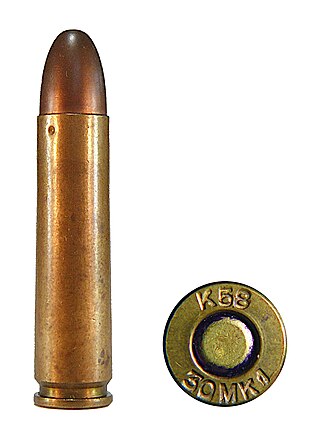
The .30 Carbine (7.62×33mm) is a rimless carbine/rifle cartridge used in the M1 carbine introduced in the 1940s. It is a light rifle round designed to be fired from the M1 carbine's 18-inch (458 mm) barrel.

The .32-20 Winchester, also known as .32 WCF , was the first small-game lever-action cartridge that Winchester produced. It was initially introduced as a black-powder cartridge in 1882 for small-game, varmint hunting, and deer. Colt produced a single-action revolver chambered for this cartridge a few years later.
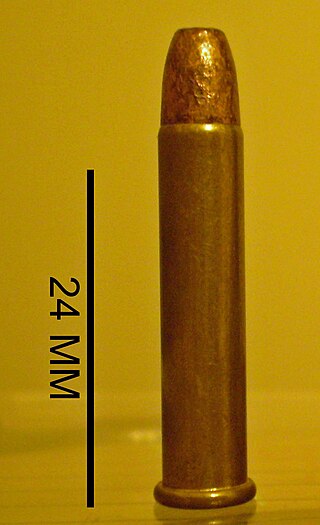
The .22 Winchester Magnum Rimfire, also called .22 WMR, .22 Magnum, .22 WMRF, .22 MRF, or .22 Mag, is a rimfire cartridge. Originally loaded with a bullet weight of 40 grains (2.6 g) delivering velocities in the 2,000 feet per second (610 m/s) range from a rifle barrel, .22 WMR is now loaded with bullet weights ranging from 50 grains (3.2 g) at 1,530 feet per second (470 m/s) to 30 grains (1.9 g) at 2,200 feet per second (670 m/s).
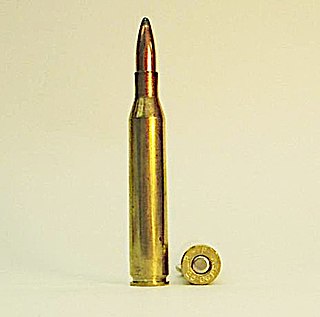
Considered by many as the most balanced of the "quarter bores" for hunting medium-sized game, the .25-06 Remington remained in obscurity as a wildcat cartridge for nearly half a century before being standardized by Remington in 1969.
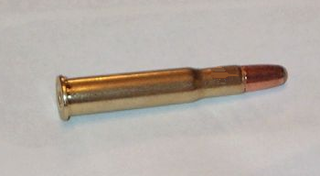
The .30-30 Winchester cartridge was first marketed for the Winchester Model 1894 lever-action rifle in 1895. The .30-30, as it is most commonly known, along with the .25-35 Winchester were offered that year as the United States' first small-bore sporting rifle cartridges designed for smokeless powder. Since its introduction, it has been surpassed by many cartridges in the long-range shooting attributes of speed, energy, and trajectory, yet remains in widespread use because of its practical effectiveness in forested hunting situations.

The .25-35 Winchester Center Fire was introduced in 1895 by Winchester for the Winchester Model 1894. Together with the .30-30 Winchester, it was one of the earliest smokeless cartridges designed in North America for a sporting rifle. Savage adopted it for its Savage Model 99 lever-action rifles. The case was based on the .30-30 cartridge.

The .350 Remington Magnum was introduced in 1965 by Remington Arms Company for the Model 600 rifle. It was later offered in the Model 660 and Model 700 rifles but was discontinued as a regular factory chambering in 1974 after a poor sales record. Remington has also offered the Model Seven MS from their Custom Shop and a limited edition 700 Classic in recent years chambered in .350 Remington Magnum. Remington began chambering the round in the new Model 673 Guide Rifle in 2002. This caliber was also sold as a chambered size configuration in a line of long range shooting and competition handguns, the Remington XP-100.

The .35 Whelen is a powerful medium-bore rifle cartridge that does not require a magnum action or a magnum bolt-face. The parent of this cartridge is the .30-06 Springfield, which is necked-up to accept a bullet diameter of .358 in (9.1 mm). This cartridge is more powerful than its parent, especially in killing power on large game. However, with much wider availability, and the higher BC .30 caliber bullets of today, the power gap between the two cartridges has been decreased.

An intermediate cartridge is a rifle/carbine cartridge that has significantly greater power than a pistol cartridge but still has a reduced muzzle energy compared to fully powered cartridges, and therefore is regarded as being "intermediate" between traditional rifle and handgun cartridges.
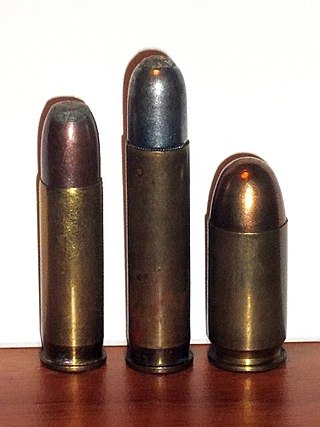
The .351 Winchester Self-Loading is an American rifle cartridge designed in 1906.

The .35 Winchester Self-Loading is an American rifle cartridge.

The Winchester Model 1905, is a blowback-operated, semi-automatic rifle produced by the Winchester Repeating Arms Company beginning in 1905 and discontinued in 1920. This rifle loads cartridges from a 5 or 10-round capacity, detachable box magazine located immediately forward of the trigger guard. Winchester offered factory chamberings in .32SL and .35 Winchester Self-Loading.

The .401 Winchester Self-Loading is an American rifle cartridge.

The Winchester Model 1907 is a blowback-operated, semi-automatic rifle produced by the Winchester Repeating Arms Company beginning in 1907 with production ending in 1957. It fired a cartridge of intermediate power, cycled through a semi-automatic operating mechanism, fed from a 5, 10, or 15 round detachable box magazine located immediately forward of the trigger guard. In size and handling, it is much like an M1 carbine, though the 1907 is heavier and fires a much harder hitting round.
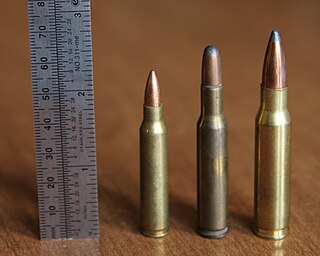
The .25 Remington is an American rifle cartridge. A rimless, smokeless powder design, this cartridge was considered to be very accurate by period firearm experts and suitable for game up to deer and black bear. It was based on the .30 Remington cartridge.

The .32 Remington is an American rifle cartridge. A rimless, smokeless powder design, this cartridge was once considered to be suitable for game larger than deer and black bear. Similar contemporary cartridges include the rimmed .32 Winchester Special, a cartridge introduced by Winchester and offered as a chambering in Winchester's lever-action rifles.



















